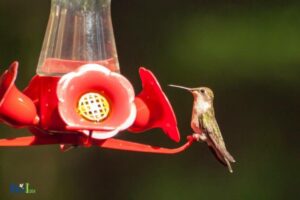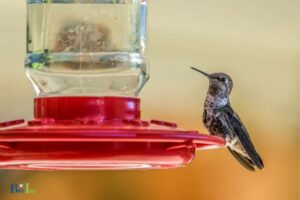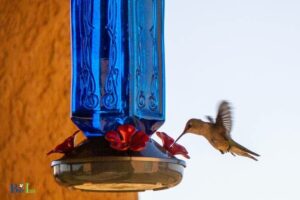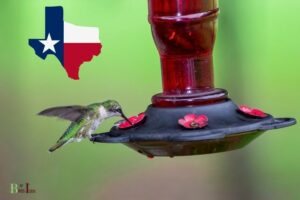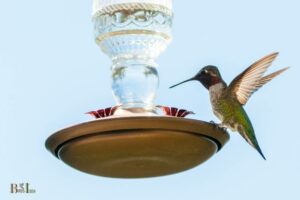How to Get Rid of Bees From Hummingbird Feeder?
Use bee deterrent methods on hummingbird feeders.
Implementing various bee deterrent methods can help prevent bees from invading hummingbird feeders and allow the birds to feed in peace.
By using bee-resistant hummingbird feeders, incorporating moats, changing the feeder’s location, and utilizing a non-toxic visual deterrent, you can efficiently prevent bees from overtaking the feeder.
This will ensure that hummingbirds can feed without any disturbances from unwanted pests.

7 Methods to Get Rid of Bees From Hummingbird Feeder:
| Method | Description | Pros | Cons |
|---|---|---|---|
| Bee Guards | Attach bee guards to the feeding ports of the hummingbird feeder. | Easy to install and effective in preventing bees from reaching the nectar. | May not work if bees are persistent or if the guards do not fit the feeder properly. |
| Move the Feeder | Relocate the hummingbird feeder to a different location in your yard. | Can confuse bees and make it harder for them to find the feeder. | Hummingbirds may take some time to find the new location, and bees may eventually find it again. |
| Use Saucer-style Feeders | Switch to a saucer-style hummingbird feeder, which has a shallower nectar reservoir. | Bees are less able to reach the nectar in saucer-style feeders. | Some hummingbirds may prefer other types of feeders, so it might take time for them to adapt. |
| Reduce Yellow Colors | Avoid using yellow-colored feeders or accessories, as yellow attracts bees. | Can help minimize the number of bees attracted to the feeder. | May not completely deter bees, especially if there are limited nectar sources nearby. |
| Add a Water Source | Provide a water source, such as a shallow dish, for bees away from the hummingbird feeder. | Can help distract bees from the feeder by providing an alternative source of water. | Requires regular maintenance to keep the water clean and fresh. |
| Apply Vaseline | Apply a thin layer of Vaseline around the feeder ports and hanger. | Makes it difficult for bees to land and access the nectar. | Can be messy and needs reapplication, and may deter hummingbirds if applied excessively. |
| Use Nectar with Less Sugar | Prepare nectar with a lower sugar concentration (e.g., 5 parts water to 1 part sugar). | Less attractive to bees, but still provides nutrition for hummingbirds. | May not be as effective if bees are persistent or if there are limited alternative nectar sources. |
How to Keep Bees Away from Hummingbird Feeders
Bees are often attracted to hummingbird feeders because they provide a sweet, accessible source of nectar.
While bees play an essential role in the environment and pollination, they can be problematic for hummingbirds and birdwatchers trying to enjoy their backyard feeders.
To keep bees away from hummingbird feeders, several strategies can be employed to deter them from invading the feeders while still providing a nectar source for the hummingbirds.
- Choose bee-resistant feeders: Opt for hummingbird feeders that have a bee guard, which is designed to prevent bees from accessing the nectar while still allowing the hummingbird’s long bill and tongue inside.
- Keep the feeder area clean: Ensure there is no spilled nectar on the outside of the feeder, as this can attract bees. Regularly clean the feeder to prevent leakage and accumulation of sticky residue.
- Provide a separate nectar source for bees: Placing a shallow dish filled with a sugar-water solution in a separate location can distract bees from the hummingbird feeders.
- Adjust the sugar-water ratio for hummingbirds: Increase the sugar-to-water ratio in the hummingbird feeders to make it less attractive to bees (e.g., use a 5:1 water-to-sugar ratio). Hummingbirds can still enjoy this solution without attracting bees.
- Add visual deterrents: Hang ornaments, like windsocks or reflective ribbons near the hummingbird feeders to deter bees visually.
Experiment with using different colors for the hummingbird feeders, as bees are attracted to bright colors like red and yellow. Switching to feeders with cooler colors, like blue or green, may help deter bees.
What Causes Bees to Swarm Around Hummingbird Feeders?
Bees are attracted to hummingbird feeders primarily because of the sweet nectar that these feeders contain.
The sugar in the solution mimics the natural sweetness found in flowers, making it an irresistible treat for bees.
Additionally, the bright colors of the feeders can also attract bees, as they are drawn to similarly colored flowers.
To deter bees from swarming around hummingbird feeders, proper maintenance and strategic placement of the feeders are crucial.
- Use bee-resistant feeders
- Keep the feeder clean and free of spills
- Change the nectar frequently
- Avoid using yellow or orange feeders
- Place the feeder in a shady location
- Add a water source near the feeder for bees
- Use a bee guard or moat
Consider planting flowers that are more attractive to bees, such as lavender or bee balm, at a distance from the hummingbird feeder.
This may help redirect the bees’ attention and provide a natural food source for them, while also allowing hummingbirds to enjoy their feeder in peace.
“Bees are important pollinators, but they can be a nuisance at hummingbird feeders. Fortunately, there are ways to discourage them without harming them.”
birdsidea
What Solutions are Available to Deter Bees from Hummingbird Feeders?
Bees are attracted to hummingbird feeders because they contain sugar water, which provides an easily accessible energy source.
While bees are important pollinators and should not be harmed, it’s essential to keep them away from hummingbird feeders to allow the birds to feed properly.
There are several effective solutions to deter bees from hummingbird feeders without causing harm.
These include making changes to the feeder itself, altering the sugar water concentration, and using natural repellents.
By using these methods, you can successfully prevent bees from accessing the hummingbird feeders while still providing a safe environment for both birds and bees.
- Choose bee-resistant hummingbird feeders
- Reduce the sugar concentration in the sugar water solution
- Use natural bee repellents, such as mint or lemongrass
- Move the feeder to a new location
- Offer a separate feeder for bees
- Keep the feeder clean and free from leaks
What Natural Repellents Can be Used to Keep Bees Away from Hummingbird Feeders?
To keep bees away from your hummingbird feeders, there are several natural repellents that can be used without harming the birds or the environment.
Using these repellents helps maintain a safe and friendly environment for hummingbirds to feed while deterring unwanted bee visitors.
The following natural repellents can effectively keep bees at bay and make your hummingbird feeder a more exclusive space for these fascinating little birds:
- Essential oils
- Dish soap and water solution
- Bee guards
- Surrounding plants
- Relocating the feeders
- Reducing spillage
DID YOU KNOW
According to a study by the US National Park Service, hummingbirds have a weak sense of smell and are attracted to bright colors, especially red. By using yellow and clear feeders, you can help reduce bees’ attraction to the feeder.
birdsidea
What Tips Can be Used to Keep Bees Away from Hummingbird Feeders?
Bees are often attracted to hummingbird feeders due to the sweet nectar within. However, there are several tips and strategies that can be used to prevent bees from invading and dominating the feeders meant for hummingbirds.
These methods will allow for a peaceful coexistence between the two species, while ensuring that hummingbirds have access to the nectar they enjoy.
- Use bee guards on the feeder
- Use feeders with less yellow parts, which can attract bees
- Keep the outside of the feeder clean to prevent sugar buildup
- Move the feeder to a new location
- Utilize feeders with built-in ant moats
- Fill the feeder with a less-concentrated nectar solution (3:1 or 4:1 water to sugar ratio)
- Hang multiple feeders to disperse the bees between them
- Hang a decoy feeder with sugar water for the bees
What Habits Should be Avoided to Prevent Bees from Attracting to Hummingbird Feeders?
To prevent bees from being attracted to hummingbird feeders, it is essential to avoid certain habits that may lure them into the area.
Bees are drawn to sugary substances, and while hummingbirds also enjoy nectar, certain adjustments can be made to deter bees without affecting the birds.
- Avoid using overly concentrated sugar solution in the feeders.
- Choose hummingbird feeders designed to deter bees.
- Keep the feeder clean and free of leaks or spills.
- Change the nectar frequently to prevent fermentation.
- Position the feeder in a shaded area away from bright colors that attract bees.
- Use a bee guard or water moat to keep them away from the feeder.
What Alternatives to Bees are Attracted to Hummingbird Feeders?
While bees are attracted to hummingbird feeders due to their sugar content, there are alternatives that can be lured to the feeder while reducing the number of bees.
These alternative pollinators can help maintain the ecosystem without causing harm to the hummingbirds.
However, it is important to make small changes to your feeder setup to discourage bees and attract these alternatives.
Alternative pollinators for hummingbird feeders:
- Butterflies
- Moths
- Wasps
- Flies (syrphid/flower flies)
- Beetles
- Ants (Though ants can be pests, some species are also known to be pollinators.)
Tips to attract alternative pollinators and keep bees away:
- Use bee guards: Install bee guards on the feeding ports to prevent bees from accessing the nectar.
- Change nectar concentration: Reduce the sugar content in the nectar, as higher sugar concentrations attract more bees.
- Move the feeder: Change the location of the feeder, as the bees might have already marked the area with scent.
- Use red nectar: Bees are less attracted to red nectar, while other pollinators are more likely to be attracted.
Conclusion
In conclusion, bees can be a nuisance for hummingbirds and their feeders, but there are various solutions to keep them away. Some natural repellents include peppermint oil and vinegar, while commercial bee guards and feeders with bee-resistant ports can also be purchased.
Additionally, avoiding overfilling the feeder and regularly cleaning it can prevent spills and leaks that attract bees. If all else fails, consider hanging a second feeder filled with sugar water for the bees to enjoy while leaving the main feeder for the hummingbirds.
Overall, with a few simple tips and tricks, you can enjoy watching these beautiful birds without unwanted guests buzzing around their feeder.
TL;DR:
- Use natural repellents like peppermint oil or vinegar
- Purchase commercially available bee guards or bee-resistant feeders
- Avoid overfilling and regularly clean the feeder
- Hang a separate feeder for bees
- Enjoy watching hummingbirds without unwanted bee guests
Action List:
- Use natural repellents such as peppermint oil or vinegar to deter bees
- Purchase bee guards or bee-resistant feeders to prevent bees from accessing the feeder
- Avoid overfilling the feeder and regularly clean it to minimize spills and leaks that attract bees
- Consider hanging a separate feeder filled with sugar water for the bees
- Enjoy watching hummingbirds without unwanted bee guests!
How to Get Rid of Bees from Hummingbird Feeder FAQ
How can I prevent bees from coming to my hummingbird feeder?
What nectar should I use in my hummingbird feeder?
How can I get rid of bees that are already at the hummingbird feeder?
If they still keep coming back, you may want to try using a bee repellent spray specifically made for use around hummingbirds or move the feeder into a closed area such as a screened-in porch.
Is there a certain time of year when bees are more attracted to hummingbird feeders?
What is the best solution for hummingbird feeder?
If you are having trouble with bees swarming your hummingbird feeder, there are a few solutions that may help.
The following solutions can help minimize the presence of bees while still attracting hummingbirds:
- Relocate the feeder away from flowers and flowering plants as bees are usually attracted to these areas.
- Use a hummingbird feeder with bee guards or modify your current feeder with bee guards to prevent bees from entering the feeder.
- Use a feeder with smaller ports as bees cannot fit their bodies through small openings.
- Use a nectar solution that has a higher concentration of water to sugar (4 parts water to 1 part sugar) as bees are less attracted to this ratio.
By implementing these solutions, you can safely attract hummingbirds to your feeder without worrying about bees.
What cleans hummingbird feeders?
If you’re struggling with bees or other insects swarming around your hummingbird feeder, you need to clean it to keep the insects away and protect the health of the birds.
The best way to clean your hummingbird feeder is to use a solution of hot water and vinegar. Follow these steps for cleaning:
- Empty the feeder of any remaining nectar.
- Disassemble the feeder as much as possible and rinse any leftover nectar or debris with hot water.
- Use a bottlebrush and hot, soapy water to scrub the feeder and all its components thoroughly.
- Rinse the feeder and its components with hot water.
- Soak the feeder and its components in a solution of one part vinegar to four parts hot water for an hour.
- Rinse the feeder and its components thoroughly with hot water.
- Allow the feeder to air dry completely before refilling it with fresh nectar.
Regular cleaning and maintenance of your hummingbird feeder using this method will help keep it clean and free from insects.
Can I spray vinegar on Hummingbird Feeder?
Yes, you can spray vinegar on the hummingbird feeder to get rid of bees. Here are the steps you can follow to do it effectively:
- Mix equal parts of water and white vinegar in a spray bottle.
- Spray the solution on and around the feeder, focusing on areas where the bees are gathering.
- Make sure to thoroughly clean the feeder afterward to remove any traces of vinegar, as it may deter hummingbirds from feeding.
- Consider adding bee guards or choosing feeders with built-in bee guards to prevent bees from accessing the nectar.
It’s important to note that while vinegar can be an effective solution for deterring bees, it may not work for all situations.
If the bees are particularly aggressive or persistent, it may be best to remove the feeder for a period of time to allow the bees to move on naturally.
Can you use baking soda to clean a Hummingbird Feeder?
Yes, you can use baking soda to clean a hummingbird feeder to get rid of bees. Here’s how:
- Mix one part baking soda with three parts hot water in a bowl or container.
- Use a bottle brush or pipe cleaner to scrub the feeder, focusing on any areas where bees may have been swarming.
- Rinse the feeder thoroughly with hot water to remove any residue.
- Refill the feeder with fresh nectar and hang it back up in a shaded area away from direct sunlight.
Baking soda is a natural cleaner that can help to remove any stuck-on debris or bee pheromones that may be attracting bees to your hummingbird feeder.
However, it’s important to clean your feeder regularly, at least once a week, to prevent the buildup of mold and bacteria that could be harmful to the hummingbirds.
Additionally, consider using a bee guard or other deterrent to keep bees away from the feeder in the first place.
Is baking soda safe for birds?
While baking soda is a natural and effective way to get rid of bees from hummingbird feeders, it is important to consider its safety for birds.
Baking soda can be harmful to birds if ingested, so it is crucial to make sure that it does not contaminate the nectar in the feeder. To ensure the safety of the birds, it is recommended to follow these steps:
- Clean the feeder thoroughly before applying the baking soda solution.
- Rinse the feeder well with water to remove any traces of baking soda.
- Use a ratio of 1 teaspoon of baking soda to 4 cups of water for the solution.
- Apply the solution to the parts of the feeder that bees are attracted to.
- Monitor the feeder regularly to make sure there are no signs of contamination or harm to the birds.
By taking these precautions, using baking soda to get rid of bees from hummingbird feeders can be a safe and effective solution.
How do you clean bird feeders with vinegar?
If you are trying to get rid of bees from your hummingbird feeder, cleaning the feeder with vinegar can be an effective solution.
Simply follow these steps to clean your bird feeder with vinegar:
- Empty the feeder completely and dispose of any old nectar.
- Mix a solution of one part white vinegar to four parts water.
- Soak the feeder in the vinegar solution for at least an hour.
- Use a bottle brush to scrub the feeder, paying special attention to any hard-to-reach areas.
- Rinse the feeder thoroughly with water.
- Allow the feeder to air dry completely before refilling it with fresh nectar.
By regularly cleaning your hummingbird feeder with vinegar, you can help to deter bees and other insects from taking over the feeding station.
It is also important to note that while bees are important pollinators, they can become aggressive around hummingbird feeders, making it uncomfortable for both the birds and humans in the area.

